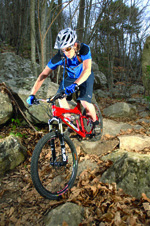 FRAME
FRAME
We took it upon ourselves to build the Foes and while the welding and paint finish is exemplary, we had to file out a burr inside the head tube to be able to press in the upper headset cup. We also had to chase the threads in the bottom bracket before fitting the box-fresh Shimano external bearing cups. Obviously if you have your bike built at a shop these niggles will be taken care of for you, but it’s not quite the quality finish that you’d expect from a US frame. Everything else went together fine, but when the bike was fully built we discovered that the Mission Control adjusters on the Lyrik Solo Air fork glance the underside of the down tube. An easy fix would be to swap the bottom headset cup for one with a taller stack height. At 8.42lb the frame weight with shock is porky, but the bulk of the extra weight is in the 1.95lb ITD Curnutt shock and Ti spring.
SUSPENSION
The Foes FXR is a single-pivot design where the pivot is located slightly in front of the bottom bracket and on the mid-line between the middle and granny ring. A CNC-machined swing link anchors the upper portion of the swingarm to the front triangle, improving frame stiffness and isolating the shock from side loads. It is not used to give a variable leverage ratio. The 2:1 tag on the Foes refers to the low average leverage ratio, where most bikes typically run between 2.5-3:1 leverage ratios. Reducing the leverage ratio lowers the spring rates and puts less strain on the frame and shock, while improving damping control.
SET-UP
When we ordered the test frame Foes took our rider weight so that the spring rate would be correct. When we sat on the bike it was obvious that it was over sprung as we were only getting 1?2 an inch of sag from the 3in stroke shock. Swapping to a 250lb spring gave us 3?4in of sag, which is 25 per cent of the total travel. Dropping the air pressure in the shock to 55psi reduced the platform effect but this also reduces end stroke damping, causing the shock to bottom-out easily. The only option was to increase the pressure and have a slightly harsher ride.
PERFORMANCE
Two to three rides in and the Curnutt shock started to loosen up and the rear suspension of the Foes started to improve. Although not as plush as the Nomad, the FXR offers a better riding position as there is more room up front for out-the-saddle efforts without the bike becoming unwieldy. Even with the tall 160mm Lyrik fork up front we never craved a travel adjuster when climbing and the FXR offers sharp handling in tight singletrack. There is no detectable pedal feedback and very little bob. And given its weight, the Foes climbed noticeably quicker than the Intense 6.6. Yes the Curnutt shock hisses on every hit, but we quickly forgot about it.
When it comes to descending we would have liked the back end of the Foes to sit into its travel more, offering a slightly slacker head angle and more predictable handling. After all, this is an 8.42lb frame, and a solid one at that, and if you can’t go any faster on the descents, what’s the point in carrying that extra weight?
VERDICT
With more time for the Curnutt shock to fully bed-in the suspension performance could start to approach that of the Nomad, but when we set the ITD shock with minimum platform for maximum plushness the shock bottomed out too easily. In hindsight we should have tested the FXR with the more expensive XTD shock, as it has independent bottom-out adjustment. The position of the Foes is excellent, it’s definitely eye-catching and exclusive — but it will take some fettling to reach its full potential.
MBR RATING: 8/10



